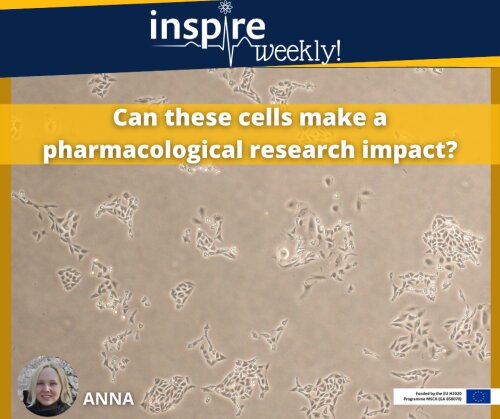09/06/2021 - Anna (ESR #15)

What do you think scientists observe on a daily basis? The picture above reproduces the view from a microscope loaded with the animal cells. These are the cells of ovarian epithelium derived from Chinese hamsters (CHO). The hamsters are easy to breed, yet once the cells were isolated in 1957 by Theodor Puck 1, there is no need anymore to keep the living hamsters for cell production. The isolated CHO cells, like any other mammalian cells, have an ability to grow and divide while being maintained in a liquid medium containing all the essential nutrients such as glucose as carbohydrate, amino acids for protein production and vitamins for the activity of enzymes within the cell. As the cells are commonly arranged into tissues, such as epithelial ovarian tissue in case of CHO cells, they retain a tendency to arrange into groups and attach to a substrate. So that these CHO cells simply grow on the bottom of a plastic Petri dish filled up with the nutrient medium. The simplicity of maintenance, cellular line stability and similarity of produced proteins to human, made CHO cells a well-known system for the production of recombinant proteins for industrial and research purposes 2. Recombinant proteins are produced by the methods of genetic engineering and incorporate the genetic material from different sources. For instance, on the picture, CHO cells were cloned (i.e. transfected) with a gene originated from jellyfish producing green fluorescent protein (GFP) 3, the glow of which is not visible under the light microscope, but you can observe its fluorescence in the next post. Another transfected gene was the gene of an ion channel. Since CHO cells do not express any cardiac-related ion transporters 1, it is a convenient system to study an ion channel of interest without any influence of other channels present in human heart tissue.
Thus, as a part of my PhD project, I am using CHO cells as a model organism to study the pharmacological effects of drugs on the cellular level. I examine these cells using a patch-clamp technique, about which I will elaborate in the next post.
References:
- Gamper N, Stockand JD, Shapiro MS. The use of Chinese hamster ovary (CHO) cells in the study of ion channels. Journal of Pharmacological and Toxicological Methods. 2005 May; 51(3):177-85
- Kim JY, Kim YG, Lee GM. CHO cells in biotechnology for production of recombinant proteins: current state and further potential. Appl Microbiol Biotechnol. 2012 Feb;93(3):917-30
- Remington SJ. Green fluorescent protein: a perspective. Protein Sci. 2011 Sep;20(9):1509-19